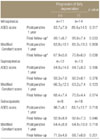Abstract
Purpose
To evaluate the influence of progressive fatty degeneration of the rotator cuff (shown on MRI after rotator cuff repair) on the clinical outcome.
Materials and Methods
At one-year postoperatively, 25 patients with progressive fatty degeneration on MRI were evaluated using the American Shoulder and Elbow Surgeon Standardized Assessment Form (ASES) score and the Constant score.
Results
Average ASES scores were 57.76±17.0 preoperatively, and had significantly increased to 84.8±11.9 at 1-year postoperatively, and to 92.7±7.7 at final follow up. Average Constant scores were 56.2±2 preoperatively, and had increased significantly to 78.2±11.7 at 1-year after surgery, and to 83.1±7.9 at final follow-up. All cases except 1 showed satisfactory results. Groups that showed re-tears, large tears or fatty degeneration on infraspinatus showed inferior results to those without these developments.
Figures and Tables
References
1. Gerber C, Walch G. Massive rotator cuff tears. 2002. Rosemont: American Academy of Orthopaedic Surgeons;191–196.
2. Gladstone JN, Bishop JY, Lo IK, Flatow EL. Fatty infiltration and atrophy of the rotator cuff do not improve after rotator cuff repair and correlate with poor functional outcome. Am J Sports Med. 2007. 35:719–728.

3. Oh JH, Kim SH, Ji HM, Jo KH, Bin SW, Gong HS. Prognostic factors affecting anatomic outcome of rotator cuff repair and correlation with functional outcome. Arthroscopy. 2009. 25:30–39.

4. Song JS, Chun JM, Park JB, Chung SJ, Kim TH. Analysis of the change in fatty degeneration of the rotator cuff and its influence on the outcome of rotator cuff repair. J Korean Orthop Assoc. 2009. 44:556–564.

5. DeOrio JK, Cofield RH. Results of a second attempt at surgical repair of a failed initial rotator-cuff repair. J Bone Joint Surg Am. 1984. 66:563–567.

6. Zanetti M, Hodler J. MR imaging of the shoulder after surgery. Radiol Clin North Am. 2006. 44:537–551.

7. Goutallier D, Postel JM, Bernageau J, Lavau L, Voisin MC. Fatty muscle degeneration in cuff ruptures. Pre- and postoperative evaluation by CT scan. Clin Orthop Relat Res. 1994. (304):78–83.
8. Goutallier D, Postel JM, Gleyze P, Leguilloux P, Van Driessche S. Influence of cuff muscle fatty degeneration on anatomic and functional outcomes after simple suture of full-thickness tears. J Shoulder Elbow Surg. 2003. 12:550–554.

9. Rubino LJ, Stills HF Jr, Sprott DC, Crosby LA. Fatty infiltration of the torn rotator cuff worsens over time in a rabbit model. Arthroscopy. 2007. 23:717–722.

10. Rubino LJ, Sprott DC, Stills HF Jr, Crosby LA. Fatty infiltration does not progress after rotator cuff repair in a rabbit model. Arthroscopy. 2008. 24:936–940.

11. Goutallier D, Postel JM, Radier C, Bernageau J, Zilber S. Long-term functional and structural outcome in patients with intact repairs 1 year after open transosseous rotator cuff repair. J Shoulder Elbow Surg. 2009. 18:521–528.

12. Liem D, Lichtenberg S, Magosch P, Habermeyer P. Magnetic resonance imaging of arthroscopic supraspinatus tendon repair. J Bone Joint Surg Am. 2007. 89:1770–1776.

13. Pfirrmann CW, Schmid MR, Zanetti M, Jost B, Gerber C, Hodler J. Assessment of fat content in supraspinatus muscle with proton MR spectroscopy in asymptomatic volunteers and patients with supraspinatus tendon lesions. Radiology. 2004. 232:709–715.

14. Frankle M, Siegal S, Pupello D, Saleem A, Mighell M, Vasey M. The Reverse Shoulder Prosthesis for glenohumeral arthritis associated with severe rotator cuff deficiency. A minimum two-year follow-up study of sixty patients. J Bone Joint Surg Am. 2005. 87:1697–1705.




 PDF
PDF ePub
ePub Citation
Citation Print
Print






 XML Download
XML Download